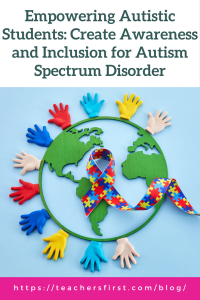“It takes a village to raise a child. It takes a child with autism to raise the consciousness of the village.”
Elaine Hall
April is Autism Awareness Month when individuals, organizations, and communities unite to increase awareness and acceptance of autism spectrum disorder (ASD). As educators, it’s essential to support and celebrate autistic students and raise awareness about ASD in your classroom community and beyond. Here are some ideas educators could use to elevate ASD awareness this month and throughout the school year.
Raise Awareness
One of the best ways to celebrate Autism Awareness Month is by spreading the word about ASD. Provide opportunities for students to learn about autism and how it impacts individuals. The following websites have resources and information you and your class can explore together.
- The website for Autism Speaks, a well-known autism advocacy organization provides a wide range of resources for individuals and families affected by autism. In addition, there is a dedicated page for Autism Awareness Month, which includes information on events and ways to get involved in advocacy efforts.
- The Autism Society is one of the oldest and largest autism advocacy organizations in the United States. Their site has a blog, resources by topic, and downloadable digital resources to help you and your students spread awareness, promote inclusion, and practice acceptance.
You can have students engage in an Autism Awareness Month scavenger hunt with either of the above websites. Here is a post that shares scavenger hunt tools and resources to get you started. After researching ASD and the history of Autism Awareness Month, students can create digital awareness posters using Google Drawings (reviewed here) or Canva (reviewed here) and share them with the school community.
Incorporate Autistic-Centered Instruction
Teachers can also support autistic students through various strategies.
- Autistic students thrive on routine and structure. Consistency in routines can help autistic students feel more secure and prepared for what is coming next. Many autistic students are visual learners, so teachers can use visual aids such as pictures or symbols to help them understand the routine and transitions. For example, you can create a visual schedule in an application like Canva (reviewed here) to show the order of activities in a day, or a picture card can be used to indicate specific activities throughout the day.
- Some Autistic students may have difficulty with unexpected changes. Teachers can offer advanced notice of any changes in the routine or schedule to help students prepare for the transition.
- Many autistic students have sensory sensitivities that can make activities more difficult. Teachers can provide sensory support, such as noise-canceling headphones or fidget toys, to help students feel more comfortable and secure during transitions.
- In general, Autistic students often have special interests that they are passionate about. These interests can be a gateway to teaching skills and helping them learn. Encourage students to write stories, essays, or blog posts about a topic of their choice. Students can use word processing applications like Google Docs (reviewed here) that also provide speech-to-text features.
In conclusion, as we celebrate Autism Awareness Month, educators must support and celebrate autistic students and raise awareness about autism spectrum disorder. By providing opportunities for students to learn about autism and how it affects individuals, teachers can help to create an inclusive classroom community. Incorporating autistic-centered instructional strategies can help autistic students thrive and succeed. As Elaine Hall said, “It takes a village to raise a child. It takes a child with autism to raise the consciousness of the village.” Let us work together to create a more understanding and accepting village for all individuals, including those with ASD.
How are you promoting autism awareness in your educational setting? Share your ideas and favorite resources in the comments below!


